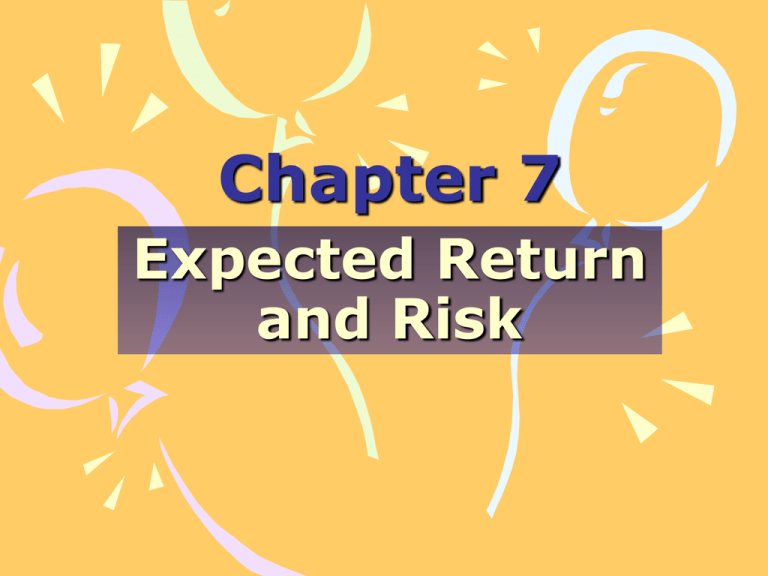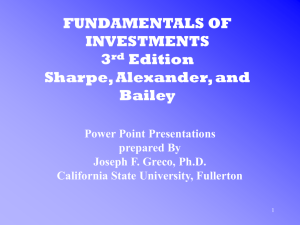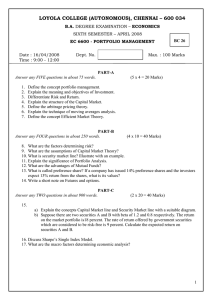Chapter 7 Expected Return and Risk
advertisement

Chapter 7 Expected Return and Risk Learning Objectives • Explain how expected return and risk for securities are determined. • Explain how expected return and risk for portfolios are determined. • Describe the Markowitz diversification model for calculating portfolio risk. • Simplify Markowitz’s calculations by using the single-index model. Investment Decisions • Involve uncertainty • Focus on expected returns – Estimates of future returns needed to consider and manage risk • Goal is to reduce risk without affecting returns – – Accomplished by building a portfolio Diversification is key Dealing with Uncertainty • Risk that an expected return will not be realized • Investors must think about return distributions, not just a single return • Use probability distributions – – A probability should be assigned to each possible outcome to create a distribution Can be discrete or continuous Calculating Expected Return • Expected value – – – The single most likely outcome from a particular probability distribution The weighted average of all possible return outcomes Referred to as an ex ante or expected return m E(R ) Ripri i1 Calculating Risk • Variance and standard deviation used to quantify and measure risk – – – – Measures the spread in the probability distribution Variance of returns: 2 = (Ri E(R))2pri Standard deviation of returns: =(2)1/2 Ex ante rather than ex post relevant Portfolio Expected Return • Weighted average of the individual security expected returns – – Each portfolio asset has a weight, w, which represents the percent of the total portfolio value The expected return on any portfolio can be calculated as: n E(Rp ) w iE(Ri ) i1 Portfolio Risk • Portfolio risk is not simply the sum of individual security risks • Emphasis on the risk of the entire portfolio and not on risk of individual securities in the portfolio Portfolio Risk • Measured by the variance or standard deviation of the portfolio’s return – Portfolio risk is not a weighted average of the risk of the individual securities in the portfolio p2 wi i2 n i 1 Risk Reduction in Portfolios • Assume all risk sources for a portfolio of securities are independent • The larger the number of securities, the smaller the exposure to any particular risk – “Insurance principle” • Only issue is how many securities to hold Risk Reduction in Portfolios • Random diversification – – Diversifying without looking at relevant investment characteristics Marginal risk reduction gets smaller and smaller as more securities are added • A large number of securities is not required for significant risk reduction • International diversification is beneficial Portfolio Risk and Diversification p % Total Portfolio Risk 35 20 Market Risk 0 10 20 30 40 ...... Number of securities in portfolio 100+ Random Diversification • Act of randomly diversifying without regard to relevant investment characteristics • 15 or 20 stocks provide adequate diversification International Diversification p % Domestic Stocks only 35 Domestic + International Stocks 20 0 10 20 30 40 ...... Number of securities in portfolio 100+ Markowitz Diversification • Non-random diversification – – – Active measurement and management of portfolio risk Investigate relationships between portfolio securities before making a decision to invest Takes advantage of expected return and risk for individual securities and how security returns move together Measuring Co-Movements in Security Returns • Needed to calculate risk of a portfolio: – Weighted individual security risks • • – Calculated by a weighted variance using the proportion of funds in each security For security i: (wi i)2 Weighted co-movements between returns • • Return covariances are weighted using the proportion of funds in each security For securities i, j: 2wiwj ij Correlation Coefficient • Statistical measure of relative comovements between security returns mn = correlation coefficient between securities m and n mn = +1.0 = perfect positive correlation mn = -1.0 = perfect negative (inverse) correlation mn = 0.0 = zero correlation Correlation Coefficient • When does diversification pay? – Combining securities with perfect positive correlation provides no reduction in risk • – – Risk is simply a weighted average of the individual risks of securities Combining securities with zero correlation reduces the risk of the portfolio Combining securities with negative correlation can eliminate risk altogether Covariance • Absolute measure of association – – – Not limited to values between -1 and +1 Sign interpreted the same as correlation The formulas for calculating covariance and the relationship between the covariance and the correlation coefficient are: m AB [R A ,i E(R A )][R B,i E(R B )]pri i 1 AB AB A B Calculating Portfolio Risk • Encompasses three factors – – – Variance (risk) of each security Covariance between each pair of securities Portfolio weights for each security • Goal: select weights to determine the minimum variance combination for a given level of expected return Calculating Portfolio Risk • Generalizations – – The smaller the positive correlation between securities, the better As the number of securities increases: • • The importance of covariance relationships increases The importance of each individual security’s risk decreases Calculating Portfolio Risk • Two-Security Case: p (w w 2wAwB AB ) 2 2 A A 2 2 B B 1/ 2 • N-Security Case: n n n ( w wi w j ij ) (i j ) P i 1 2 i 2 i 1/ 2 i 1 j 1 Simplifying Markowitz Calculations • Markowitz full-covariance model – – Requires a covariance between the returns of all securities in order to calculate portfolio variance Full-covariance model becomes burdensome as number of securities in a portfolio grows • n(n-1)/2 unique covariances for n securities • Therefore, Markowitz suggests using an index to simplify calculations The Single-Index Model • Relates returns on each security to the returns on a common stock index, such as the S&P/TSX Composite Index • Expressed by the following equation: Ri i iRM ei • Divides return into two components – a unique part, αi – a market-related part, βiRMt The Single-Index Model measures the sensitivity of a stock to stock – market movements If securities are only related in their common response to the market • • Securities covary together only because of their common relationship to the market index Security covariances depend only on market risk and can be written as: ij i j M2



